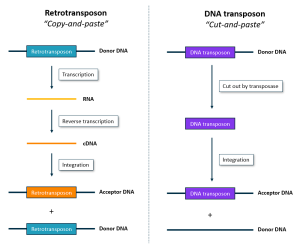Transposons in aging

Transposons were first discovered in corn (maize) by Barbara McClintock during the decades of 1940-50s, for which she won the Nobel Prize of Physiology or Medicine in 1983.[1][2][3]
Transposons, also called "jumping genes", are genes not fixed in location and are capable of changing position within the genome. Transposase enzymes bind to the end of transposon elements and catalyze their movement to other parts of the genome. Transposons have no known direct functions, but they can sometimes result in de novo mutations or changes in genome size. This can result in dangerous modifications to the genome, as they might lead to inactivation of important sequences, aberrant control of genes or tumourogenesis.
Retrotransposons, the most common type of transposons, proceeds via an RNA intermediate that can be targeted by RNA interference (RNAi) mechanisms, which then degrade these molecules to prevent their expression. Thus, RNAi is postulated to have evolved as a protective mechanism against retroviruses and endogenous retrotransposons in order to prevent their excessive activity.
Types of transposons
There are several types of transposons:
DNA-only transposons
This type of transposons, and unlike retrotransposons, are able to translocate from one chromosome to another. They code themselves for transposase enzymes, which facilitates the transferring process. DNA-only transposons do not transfer very frequently and it is unknown what process is responsible for their action.
Retrotransposons
These are the most common class of transposons in humans. They are sections of DNA inserted into the chromosome, but never jump out of it to other chromosomes. Retrotansposons transcribe their sequence of DNA into RNA copies and require the enzyme reverse transcriptase to then be converted into double-stranded DNA, which will then insert themselves elsewhere in the genome. They are named after retroviruses such as HIV, which also require reverse transcriptase to be inserted into the host chromosomes and replicate. Retrotransposons have had an important role in evolution by generating a large amount of the repetitive DNA sequences, and much of the non-coding "junk" DNA consists of this type of transposons.
Transposons in aging
Transposons as a cause of aging
Transposons are hypothesized to be a cause of aging due to some of their properties.[4] This hypothesis is based on the observation that duplication of genes during transposition, the process in which a transposon element moves to another location in the genome, might lead to inactivation of essential genes or to cause aberrant function. Thus dysfunctional processes during aging have been proposed to arise as a consequence of the large amount of transposon elements present in "junk" DNA regions, and might potentially explain the properties of senescent cells.[4]
Transposons in laminopathic diseases
Laminopathies are a type of rare genetic disorders that arise from mutations in nuclear lamina genes, which are important to maintain fibrillar networks in the nucleus and to regulate events in chromatin organisation. A reduction in the expression of some lamin genes is also associated with aging and to a deregulation of transposable elements.[5]
- ↑ McClintock, B. (1931). The Order of the Genes C, Sh and Wx in Zea Mays with Reference to a Cytologically Known Point in the Chromosome. Proceedings Of The National Academy Of Sciences, 17(8), 485-491. doi: 10.1073/pnas.17.8.485
- ↑ McClintock, B. Mutable loci in maize. Carnegie Institution of Washington Yearbook 50, 174–181 (1951).[1]
- ↑ Ravindran, S. (2012). Barbara McClintock and the discovery of jumping genes. Proceedings Of The National Academy Of Sciences, 109(50), 20198-20199. doi: 10.1073/pnas.1219372109
- ↑ Jump up to: 4.0 4.1 Murray, V. (1990). Are transposons a cause of ageing?. Mutation Research/Dnaging, 237(2), 59-63. doi: 10.1016/0921-8734(90)90011-f
- ↑ Andrenacci, D., Cavaliere, V., & Lattanzi, G. (2020). The role of transposable elements activity in aging and their possible involvement in laminopathic diseases. Ageing Research Reviews, 57, 100995. doi: 10.1016/j.arr.2019.100995